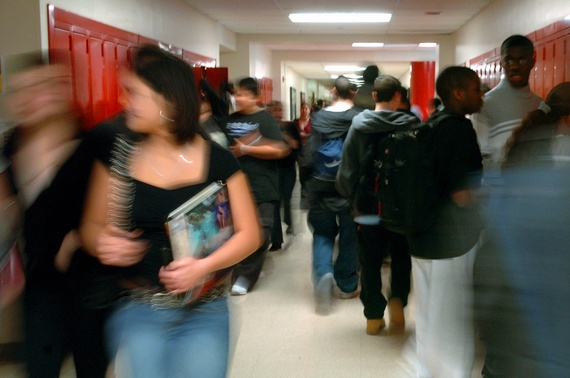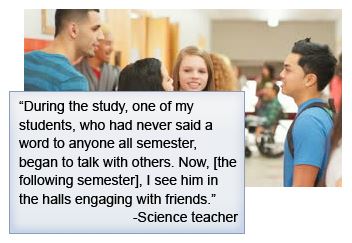 The 9th grade has been called the “make-it or break-it year.” Declines in academic achievement are common to high school freshman. Many students are simply not prepared for the increased academic expectations and eventually fail to be promoted to 10th grade.
The 9th grade has been called the “make-it or break-it year.” Declines in academic achievement are common to high school freshman. Many students are simply not prepared for the increased academic expectations and eventually fail to be promoted to 10th grade.
What can we do to keep students on track?

Researchers have recently begun to acknowledge the role of social factors in academic achievement within classrooms and schools, and they have found a strong, causal link between social maturity and success in academics, career advancement, and engagement with the community throughout one’s life.
We propose that schools nurture social development, and do so at a critical juncture – the 9th grade. We know that challenging transitions are ideal stages for fostering positive change. We also know that adolescents are going through their critical second round of brain maturation. What they learn at this stage is wired into their neural circuitry. Thus, we propose that addressing the social needs of 9th graders will foster a social mindset at a critical time of their development leading to lasting benefits at school and elsewhere.
Social Intelligence 9th Grade Transition Program
In high schools where transition systems for freshmen are fully in place, the dropout rate is only one-third as high compared with schools without full transitional programs in place. Unfortunately, there aren’t many programs in place because they are labor intensive, take away from class time, and are inconsistent in their delivery.

The Social Intelligence 9th grade internet program addresses these concerns. The program is:
- Self administered: Research shows that self-administered programs are needed, especially for socially anxious teens, as they confront an increasing complex array of social situations (Elias, 2001). We know that students’ social anxieties are rarely adequately addressed (Cauley and Jovanovich, 2006) and that group discussion formats can drive socially anxious students further away from the help they need. The Social Intelligence course can be taken at any time, in private.
- Consistently delivered using the Internet: Current programs are labor intensive. The SI program takes the burden off the often over-worked teacher. It is taught in the same way, day-in, day-out, to thousands of 9th grade students at a time. This type of program fidelity is necessary to sustain beneficial impacts over time.
- Clinically tested: The SI program has been clinically tested, peer-reviewed, and published in the PLOS One academic journal.
Contact us to get information on implementing the Social Intelligence 9th grade transition program in your high school.
________________________
References
Almeida, D. M. and Wong, J.D. (2009). Life transitions and daily stress processes. In: Elder GH Jr, Giele JZ, editors. The craft of life course research. New York: Guilford, pp. 141–162.
Balfanz, R., & Ledger, N. (2006). Closing dropout factories: The graduation rate crisis we know and what can be done about it. Education Week, 25, 42-43.
Benner, A. D. and Graham, S. (2009), The Transition to High School as a Developmental Process Among Multiethnic Urban Youth. Child Development, 80: 356–376. doi: 10.1111/j.1467-8624.2009.01265.x
Casey, BJ, Jones, RM, Hare, TA, The Adolescent Brain, Ann NY Acad Sci, 2008, March; 1124: 111-126.
Cauley, K. M., & Jovanovich, D. (2006, September). Developing an Effective Transition Program for Students Entering Middle School or High School. The Clearing House, 80(1), 15-25.
Danish, S. (1981). Life-span human development and intervention: A necessary link. Counseling Psychologist, 9, 40–43.
Eccles, J. S. (2004). Schools, academic motivation, and stage-environment fit. In R. M. Lerner, & L. Steinberg (Eds.), Handbook of adolescent psychology (2nd ed.). (pp. 125e153) Hoboken, NJ: Wiley.
Elias, M.J. 2001. Easing transitions with Social-emotional learning. Principal Leadership 1 (7):20-25.
Espelage, D.L. and De La Rue, L. (2011). School bullying: its nature and ecology. Int J Adolesc Med Health, 24, 3-10. doi: 10.1515/ijamh.2012.002.
Faris, R. and Felmlee, D. (2011). Status struggles network centrality and gender segregation in same-and cross-gender aggression. American Sociological Review, 76(1), 48-73.
Juvonen, J. (2006). Sense of belonging, social bonds, and school functioning. Handbook of educational psychology, 2, 655-674.
Kennelly, L. and Monrad, M. (2007). Easing the Transition to High School: Research and Best Practices Designed to Support High School Learning. National High School Center. Retrieved from http://files.eric.ed.gov/fulltext/ED501073.pdf
Lowenthal, M. F., Thurnher, M., and Chiriboga, D. A. (1975). Four stages of life. San Francisco: Jossey-Bass Publishers.
Lyubomirsky, S., King, L., & Diener, E. (2005). The benefits of frequent positive affect: does happiness lead to success? Psychological bulletin, 131(6), 803.
Simmons, R. G. and Blyth, D. A. (1987). Moving into adolescence: The impact of pubertal change and school context. Hawthorne, NJ: Aldine.
Strøm, I.F., Thoresen, S., Wentzel-Larsen, T., and Dyb, G. (2013). Violence, bullying and academic achievement: a study of 15-year-old adolescents and their school environment. Child Abuse Negl. 2013, 37, 243-251.
Wheelock, A. and Miao, Jing (2005) The Ninth-Grade Bottleneck: An Enrollment Bulge in a Transition Year that Demands Careful Attention and Action, School Administrator, v62 n3 p36.
Wigfield, A., Byrnes, J. P., & Eccles, J. S. (2006). Development during early and middle adolescence. In P. A. Alexander & P. H. Winne (Eds.), Handbook of educational psychology (pp. 87–105). Mahwah, NJ: Erlbaum.

